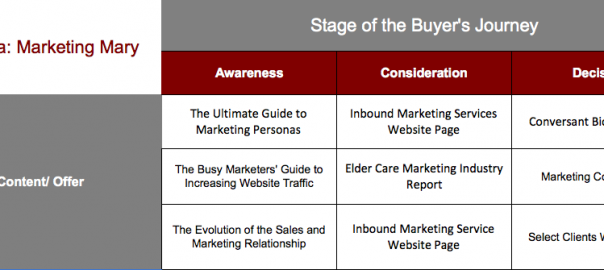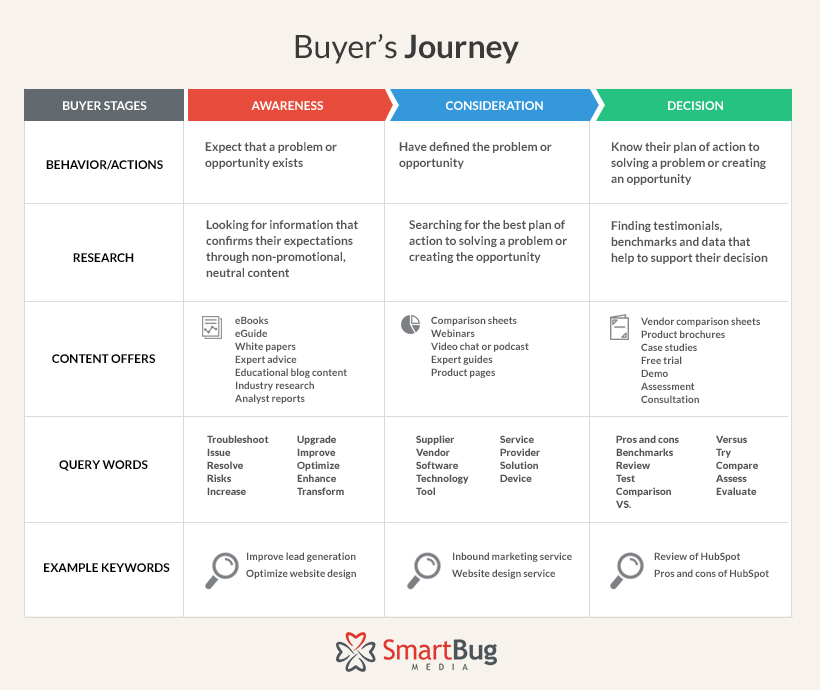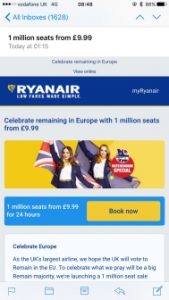Assuming your customers find you exactly when they are about to purchase is not only ignorant, it is also hurting your ability to grow leads and customers. Although variable from company to company, all customers take a journey when making a purchase. Today, this journey often involves the use of search engines.
As a marketer, I must admit that when I first began implementing SEO strategies, I was so fixed on the keywords and proper formatting on websites that I forgot that there was an actual human being that would be using the search engine(for the record, this was over four years ago when everyone and their mother approached SEO similarly). However, the buyer journey is one of the most important aspects of SEO because search engines like Google ultimately want to help buyers on their journey.
What Is a Buyer Journey?
A buyer journey, simply put, is the path a person or company will take when purchasing a product or service. This path may sometimes be quite short (e.g. I hopped on Amazon to do all of my holiday shopping in a record 30 minutes), but it can also be quite long (e.g. I spent two months researching the car I leased due to cost and impact the investment would have on my life). Each action that the customer takes on his or her way to a purchase is considered an important step in the buyer journey.
The buyer journey is an essential part of inbound marketing because it can help you identify gaps in your existing strategy. One company’s buyer journey will be wildly variable to another company’s. Even further, your company will likely have a different buyer journey for each of your buyer personas. The image below depicts a typical buyer’s journey:
Identify Buyer Personas
Before you jump into SEO or the buyer’s journey, you should have a clear understanding of your buyer personas. A buyer persona is, essentially, a profile of your ideal prospect. You can learn more about creating buyer personas in our Ultimate Guide to Inbound Marketing Personas, but here is the basic information that is important to creating a buyer persona:
- Role
- Responsibilities
- Type of company they work for
- Goals
- Pain points
- Common objections
- Identifiers (e.g. risk taker)
Once you’ve developed 3-5 buyer personas, you can begin to identify how well existing content fits the buyer persona, map it to the buyer journey, and then utilize this information to build your SEO strategy.
Map Content to the Buyer Journey
Considering SEO is used to help people find your content, aligning your SEO strategy and buyer journey starts by first mapping your content to the buyer journey. To do this, you’ll take each piece of content you have and identify the stage and buyer persona this content applies to (Content may overlap for some buyer personas). Because this exercise is to help align the journey with SEO, you should also do this with website product and service pages and also with your blogs because we’ll want to be sure later on that we’ve got search queries for all your content even if it isn’t a gated offer. If you have a significant amount of blogs, map by grouping topics. Below is an example of how this mapping should look (You can actually download some of the examples of offers in the SmartBug Resource Center).
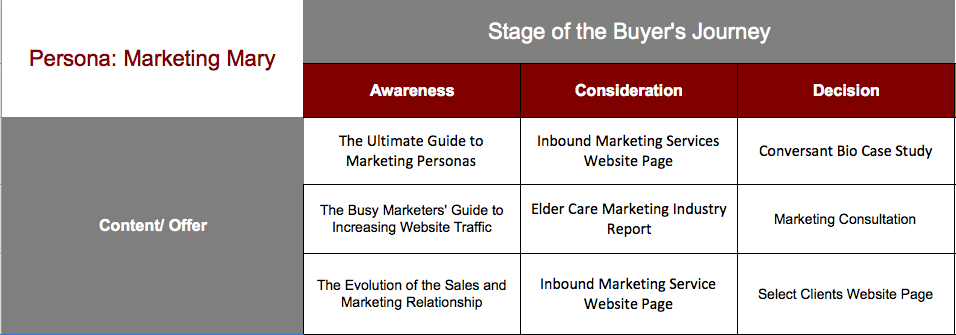
Once you have compiled a list of your content and mapped to the appropriate stage, you can complete further analysis to identify the content that you are missing for each step of the buyer’s journey. For now, let’s transition towards SEO.
Create Categories and Topics of Current & Future Content
During the buyer persona exercise, you should have identified some buzzwords, problems, goals and terminology used by each buyer persona. Use this information to compile a list of topics or categories that will then be used to form the basis of your keyword strategy. For example:
- Lead generation
- Web design
- SEO
From here, you can begin to drill further to ultimately identify target keywords.
Identify Keyword Possibilities
Now that you’ve identified the 5-10 different categories of topics, which are really the categories of your keyword strategy, you can move on to identifying the keywords for your content. To do this, take each step below:
- Start by identifying your existing ranked keywords using a tool like HubSpot
- Explore new keyword opportunities(Click here to learn more about good keyword opportunities) using the following:
- Start with a general approach by checking your categories/topics
- Discover long-tail opportunities by combining each stage’s query words with the topic(e.g. [query type = improve] + [topic = lead generation] = improve lead generation)
- Map each possible keyword target to a stage in the funnel. Some keywords may not apply to every one of your buyer persona’s journeys and some may work for more than one. Below is an example of what this may look like.
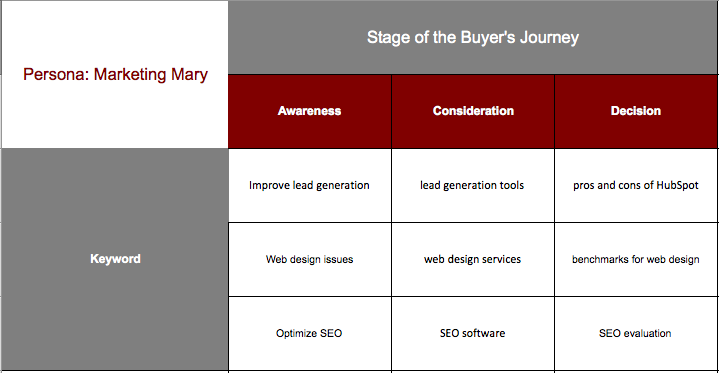
When Are Keywords Most Important in the Buyer’s Journey?
Although a buyer may search for a product or service during the consideration and decision stages, most of search occurs during the Awareness stage when the buyer is first learning about the problem and opportunity. Thus, when doing keyword research, you are likely to see more monthly searches for keywords that fall into the Awareness stage.
In addition, there is a significantly less search volume for keywords that may fall into the Decision stage. In some industries and for some buyer journeys, the buyer may not search at all during the Decision stage.
For these reasons, you should consider the following tips:
- Start by researching keywords in the Consideration and Decision stage. Low monthly search volume may mean that search isn’t used by your buyer in these stages.
- Concentrate more target keywords in the Awareness stage. This essentially widens your funnel of prospects by helping people find you before they’ve discovered the best way to solve their problem.
Where Should Keywords be Implemented?
After you’ve identified 20-30 target keywords that are optimized for you buyer’s journey and personas, you’ll have the task of implementing on your website. The intent behind the keyword or, in other words, the stage in the funnel largely dictates where keywords should be placed. There are logical steps you should take in implementing, but first let’s go over the important elements of on-page SEO. Here are all the basic elements you should be sure to add a target keywords to:
- H1 tag or headline
- Page title
- Throughout the copy of the page
- Image alt text
To learn more about optimizing website pages for SEO, download this guide.
Next, you should follow these logical steps in implementing keywords (a SEO worksheet will be valuable at this point):
- Product/Service pages: Start by identifying target keywords from your list of keywords that fit best for your core service and product website pages. These are typically the keywords found in the Decision stage.
- Persona-based pages: You’ve already broken your keywords up by persona. If you have website pages that are tailored to a persona, optimize that page for the keywords that are only relevant to that page and persona.
- Content Offers: If you’ve already got landing pages for content offers, be sure that they are optimized around one of your target keywords. Once you’ve finished optimizing existing content offers, identify areas where you need to develop content for a keyword and stage of the funnel that is lacking.
- Blogs: Your blog posts can contain keywords from each stage of the funnel and for each persona, which is why they are so helpful in growing search engine traffic. Start by optimizing existing blogs for SEO and then ensure blogs you create in the future adhere to those guidelines.
Caution, One-Size Doesn’t Fit All
As outlined, identifying buyer personas, mapping content, and then developing keywords is important because you have to have a thorough understanding of who will be doing the searching and when they will be doing the searching before implementing SEO. Utilize the advice in this article, but, by all means, take caution by considering what works best your buyer’s journey.
If you would like help developing your buyer’s journey and the content that satisfies the buyer’s needs at each stage,contact SmartBug Media today for a consultation.
Digital & Social Articles on Business 2 Community
(395)
Report Post